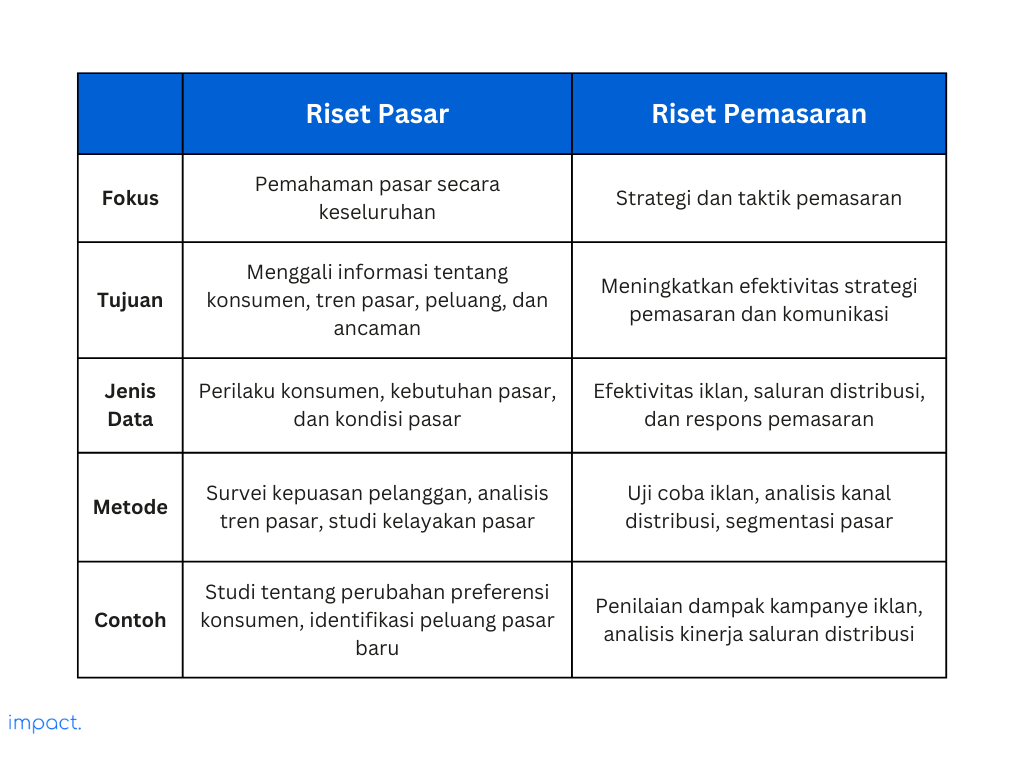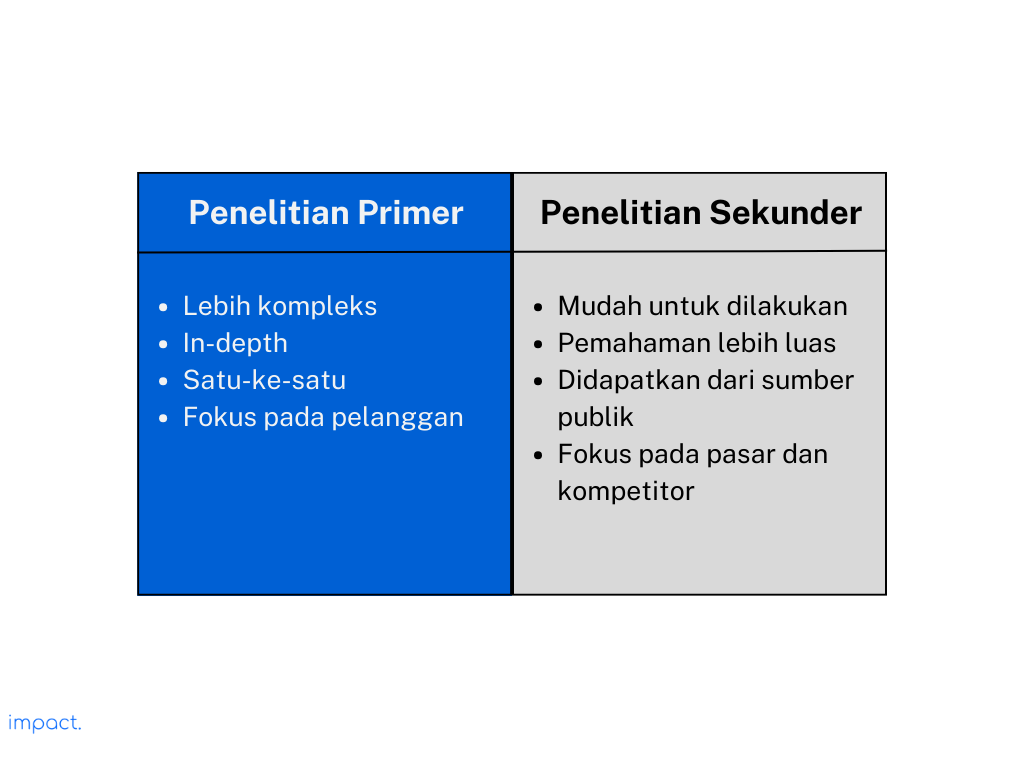8 Digital Marketing Agency Terbaik di Indonesia Tahun 2025
Strategi marketing yang tepat menjadi kunci penting untuk dapat bersaing di era digital. Digital marketing…
Nindy
April 30, 2025Market research atau riset pasar adalah usaha terstruktur untuk mengumpulkan informasi tentang target pasar dan pelanggan. Strategi bisnis ini mengambil peran penting dalam menjaga daya saing perusahaan, sehingga minatnya tumbuh pesat dalam beberapa tahun terakhir — pasar market research diprediksi mencapai $90,79 miliar pada 2025.
Berbagai metode dan teknik digunakan dalam market research untuk mendapatkan data yang relevan dan akurat. Informasi ini membantu perusahaan mengambil keputusan yang lebih tepat dan mengembangkan strategi yang lebih efektif.
Market research membantu perusahaan memahami kebutuhan, preferensi, dan perilaku pelanggan. Menurut riset Deloitte, bisnis yang lebih customer-centric menghasilkan laba 60% lebih besar.
Banyak produk alami kegagalan, dengan tingkat yang mencapai 95% menurut beberapa ahli. Sebelum meluncurkan produk atau layanan baru, riset pasar membantu Anda menguji konsep tersebut dengan audiens target. Feedback dari fase ini memungkinkan penyesuaian yang diperlukan.
Riset pasar membantu menganalisis kekuatan dan kelemahan kompetitor. Dengan memahami strategi pesaing, perusahaan dapat menemukan celah atau memperbaiki kelemahan dalam strategi mereka sendiri. Ini penting untuk tetap kompetitif di pasar yang dinamis.
Market research bukan hanya penting untuk startup atau peluncuran produk baru. Melakukan riset pasar secara berkala dapat membantu Anda menemukan peluang baru untuk berkembang. Data dari riset ini membantu bisnis mengeksplorasi segmen pasar yang belum terjangkau atau merancang produk yang sesuai dengan tren terbaru.
Salah satu tujuan utama riset pasar adalah memberikan informasi yang akurat untuk pengambilan keputusan. Data riset pasar berfungsi sebagai kompas, membantu perusahaan membuat keputusan yang mendekatkan mereka pada tujuan untuk mengonversi dan mempertahankan pelanggan target.
Riset pasar dan riset pemasaran sering dipertukarkan, padahal sebenarnya berbeda. Riset pasar bertujuan memahami pasar secara umum, sedangkan riset pemasaran fokus pada kebutuhan dan keinginan konsumen serta strategi pemasaran untuk memenuhi kebutuhan tersebut.

Tanpa tujuan yang jelas, riset pasar bisa tidak fokus dan datanya kurang relevan. Berikut beberapa pertimbangan untuk menentukan tujuan riset Anda:
Target audiens bisa berupa segmen pelanggan spesifik, prospek potensial, atau seluruh pasar. Dalam tahap ini, membuat buyer personas sangat membantu. Buyer personas adalah gambaran semi-fiktif dari pelanggan ideal Anda berdasarkan data nyata.
Pertimbangkan beberapa faktor berikut:
Artikel terkait: 8 Cara Menentukan Profil Responden dalam Riset Bisnis
Setelah menentukan tujuan dan target audiens, langkah berikutnya adalah memilih metode riset yang tepat. Ada dua metode utama: primary research dan secondary research. Pilihan metode ini bergantung pada data yang dibutuhkan dan sumber daya yang tersedia.

1. Primary research atau riset primer mengumpulkan informasi baru secara langsung dari individu atau sumber relevan dengan tujuan tertentu. Contohnya seperti survei, wawancara, observasi, atau focus group.
Kelebihan:
Kekurangan:
2. Secondary research atau riset sekunder menggunakan data yang sudah ada, seperti dari sensus pemerintah, laporan asosiasi perdagangan, jajak pendapat, atau penelitian bisnis lain di pasar yang sama.
Kelebihan:
Kekurangan:
Pengumpulan data adalah tahap di mana Anda mulai mengumpulkan informasi penting untuk menjawab pertanyaan riset. Teknik pengumpulan data harus sesuai dengan metode riset yang dipilih.
Primary Research:
Secondary Research:
Setelah mengumpulkan data, langkah berikutnya adalah menganalisis informasi untuk mendapatkan wawasan berguna. Cara analisis bergantung pada jenis data yang Anda miliki:
Analisis hasil riset harus disesuaikan dengan tujuan yang telah ditetapkan. Buat laporan yang jelas dan ringkas mengenai temuan riset.
Laporan ini perlu mencakup rekomendasi berdasarkan data yang dianalisis dan implikasinya untuk strategi bisnis atau pemasaran. Jika riset menunjukkan bahwa konsumen menginginkan fitur baru pada produk, rekomendasikan pengembangan fitur tersebut.
Setelah implementasi, penting untuk memantau dampak dari perubahan yang dilakukan. Periksa bagaimana wawasan dari riset diterapkan dalam strategi bisnis dan pastikan rekomendasi diimplementasikan dengan benar.
Evaluasi apakah tujuan riset tercapai dan data yang diperoleh relevan. Tanyakan apakah ada aspek yang perlu diperbaiki dalam proses riset untuk memastikan strategi berhasil atau perlu penyesuaian.
Starbucks telah sukses dengan ekspansi globalnya dan kini hadir di lebih dari 80 negara. Sebelum memasuki pasar baru, mereka melakukan riset pasar secara mendalam.
Saat akan membuka cabang di Tiongkok, Starbucks meneliti kebiasaan minum teh lokal dan keterbukaan kelas menengah terhadap merek Barat. Hasil riset ini memungkinkan mereka menyesuaikan menu dengan selera lokal, termasuk menambahkan cita rasa populer ke dalam tawaran mereka.
LEGO dulu dikenal sebagai perusahaan mainan untuk anak laki-laki. Namun, mereka tidak ingin membatasi diri dan ingin semua anak bisa menikmati produk mereka.
Pada 2012, LEGO melakukan penelitian pada 3.500 anak perempuan dan ibu mereka untuk memahami preferensi bermain mereka. Dari penelitian ini, lahirlah lini mainan baru yang sesuai keinginan anak perempuan. Hasilnya, pendapatan LEGO naik menjadi 23,4 miliar kroner ($4,2 miliar) dan laba bersih mereka tumbuh 38 persen, menjadi 5,6 miliar kroner ($1 miliar) di tahun berikutnya.
Komunikasi yang jelas dan terbuka dengan tim riset dan peserta sangat penting. Keterampilan komunikasi verbal dan tulisan harus kuat agar informasi dapat disampaikan dengan jelas dan laporan terdokumentasi dengan baik.
Pastikan semua pihak yang terlibat memahami tujuan riset dengan baik. Berikan panduan yang jelas kepada peserta, baik dalam survei, wawancara, maupun focus groups.
Waktu peserta sangat berharga, jadi buat survei dan kuesioner singkat dan padat. Fokus hanya pada pertanyaan yang penting untuk tujuan riset Anda.
Hindari membuat kuesioner yang terlalu panjang, rumit, atau membingungkan. Survei yang memakan waktu lebih dari 5 menit cenderung mengurangi tingkat respons hingga 15%, dan turun 40% jika melewati 10 menit.
Memberikan insentif adalah cara efektif untuk meningkatkan partisipasi dan kualitas jawaban. Insentif bisa berupa hadiah fisik, voucher, diskon, atau poin reward yang dapat ditukar.
Dengan insentif, peserta lebih termotivasi untuk berpartisipasi dengan antusias serta memberikan jawaban yang jujur dan lengkap. Pastikan insentif yang diberikan sesuai dengan skala riset dan anggaran Anda.
Baca juga: 8 Cara Menentukan Profil Responden dalam Riset Bisnis
Memahami persepsi dan posisi merek di pasar sangat penting untuk strategi pemasaran yang efektif. Brand research membantu mengidentifikasi bagaimana konsumen memandang merek Anda dibandingkan dengan pesaing.
Penelitian ini bisa mencakup survei tentang kesadaran merek, loyalitas pelanggan, dan atribut merek yang dianggap penting oleh konsumen. Hasilnya akan memberikan wawasan penting untuk mengarahkan keputusan strategis yang dapat meningkatkan citra dan kekuatan merek di pasar.
Salah satu bahaya market research adalah membiarkan asumsi memengaruhi hasil. Terlalu mudah untuk melihat pola dan membuat asumsi tanpa menyelidiki lebih dalam mengapa tren tertentu terjadi.
Gunakan berbagai metode riset untuk memastikan data yang Anda kumpulkan mencerminkan realitas pasar dan kebutuhan konsumen. Ini akan membantu Anda membuat keputusan yang lebih tepat dan akurat.
Menggunakan software untuk pengumpulan data bisa meningkatkan efisiensi dan akurasi riset pasar. Dua jenis yang dapat digunakan:
Riset pasar adalah alat penting bagi perusahaan untuk memahami kebutuhan konsumen dan mengurangi risiko. Dengan menggunakan metode yang tepat dan mengumpulkan data yang relevan, perusahaan bisa membuat keputusan yang lebih baik dan merancang strategi bisnis yang efektif.
Selalu perbarui market research sesuai dengan perubahan tren dan kebutuhan konsumen. Dengan riset yang efektif, perusahaan dapat tetap kompetitif dan responsif terhadap dinamika pasar yang terus berubah.
Tim Insights Impact
Tim Insights Impact terdiri dari beragam individu profesional yang memiliki keahlian dan pengalaman dalam berbagai aspek bisnis. Bersama-sama, kami berkomitmen untuk memberikan wawasan mendalam dan pemahaman yang berharga tentang berbagai topik terkait strategi bisnis dan tren industri yang relevan.
75% proyek transformasi digital gagal. Ambil langkah pertama yang tepat dengan memilih partner yang dapat dipercaya untuk jangka panjang.
